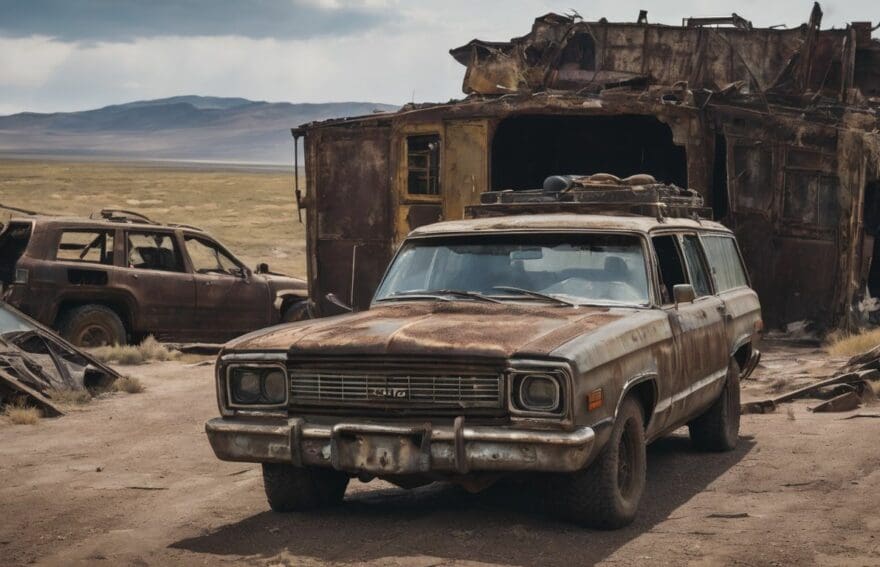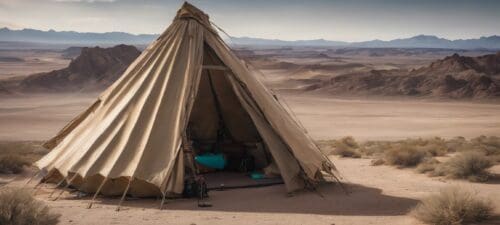Rust: Survival of the Fittest in a Harsh Environment

Updated On: November 22, 2025 by James Connolly
Are you tired of struggling to survive in the harsh wilderness of Rust? We understand your frustration, as we’ve also faced the challenges of managing hunger, thirst, and health in this unforgiving game. Through our extensive research and experience, we have discovered effective strategies for conquering the elements and thriving in Rust’s challenging environment. Join us on a journey to learn how to adapt and survive against all odds in Rust: Survival of the Fittest.
Explanation of the game “Rust”
In Rust, we find ourselves thrust into a savage wilderness with nothing but our wits to keep us alive. We must hunt, gather resources, and craft gear to fend off the elements—and each other.
Hunger gnaws at our bellies and thirst parches our throats, while health hangs by a thread in the face of relentless danger. Every choice determines whether we conquer this open world or fall victim to its ruthless laws.
We navigate a randomly-generated map filled with threats and opportunities, constructing shelters for safety against harsh weather and hostile wildlife. Our survival hinges on managing vital needs and making strategic decisions that could mean life or death.
It’s an unforgiving contest of endurance where collaboration can be as precarious as going it alone—trust is rare but can yield powerful alliances amidst the corrosion of humanity that lurks within this tough environment.
Brief overview of its gameplay
In Rust, we’re thrown into a relentless open-world environment with one goal: survive by any means necessary. We start with nothing but a rock and a torch, forced to gather materials from the wild landscape around us.
Every tree can offer wood, every stone might yield metal ore – essential supplies for crafting tools and weapons. Hunger and thirst drive our search for food and water while we keep an eye out for danger lurking in the underbrush.
Our survival hinges not just on battling the elements but also facing other players who may be friend or foe. We cobble together shelter, form alliances, fend off wildlife attacks, and sometimes engage in combat with others fighting for their place in this unforgiving world.
Strategy is key as we navigate through diverse biomes each posing new threats and opportunities; there’s no telling what unknown hazards lie within the next valley or over the pinnacle of that silent ridge.
Let’s move on to understanding how these various environments shape our journey in Rust.
Navigating Rust’s Harsh Environments and Weather Conditions
We will discuss the challenges of different biomes and how weather conditions impact gameplay in Rust, so strap in for an enlightening read into surviving the elements. Ready to tough it out? Click below to dive deeper into navigating Rust’s harsh environments!
Different biomes and their challenges
Different biomes in Rust present unique challenges to players. From the dense forests with limited visibility to the open plains with little cover, each biome demands adaptability and strategy.
Harsh weather conditions such as extreme cold or scorching heat add an additional layer of difficulty, requiring players to gather specific resources or seek shelter to survive.
Navigating these challenging environments calls for resilience and resourcefulness. Players must be prepared to face hostile wildlife, rugged terrain, and limited food and water sources.
Each biome offers a distinct set of obstacles that demand toughness and determination from players looking to conquer the elements.
Impact of weather on gameplay
The weather in Rust can significantly impact gameplay. Severe conditions such as rain or snow can affect a player’s health, hunger, and overall survival. Harsh weather makes gathering resources more challenging and increases the risk of encountering hostile wildlife.
Additionally, extreme weather can also hinder visibility and make navigation within the game more difficult.
Building structures for protection against adverse weather becomes crucial in order to survive longer in Rust. Players need to adapt their strategies according to changing weather patterns and use specific items like clothing or shelter to mitigate the effects of harsh conditions on their characters’ well-being and overall progress within the game.
Adapting to Environments for Survival
Gathering resources and building structures are essential for survival in Rust’s unforgiving landscapes, read on to discover how to thrive in the game’s challenging environments.
Importance of gathering resources
Gathering resources is vital in Rust. We need these materials to build bases, craft weapons, and survive against the harsh environment and other players. Whether it’s wood for constructing shelters, metal for fortifying defenses, or food and water to sustain ourselves, gathering resources is an ongoing task that requires diligence and strategy.
We must venture out into the wilderness to collect these essential items while keeping a watchful eye on our surroundings. Without enough resources at our disposal, survival becomes much more precarious.
As we gather materials, we increase our chances of thriving in the brutal world of Rust.
Building structures for protection
- Choosing a strategic location: Select a location that offers natural defences, such as cliffs or mountains, to minimise vulnerability to attacks.
- Gathering materials: Collect wood, stone, and other resources to construct the foundation and walls of your base.
- Designing a strong layout: Plan an efficient layout for your base with multiple layers of defence including walls, gates, and watchtowers.
- Securing entry points: Install doors, traps, and locks to prevent unauthorised entry into your base.
- Crafting defensive tools: Build weapons like turrets and traps to deter potential threats from approaching your base.
- Establishing a perimeter: Create a secure perimeter around your base using fences or barriers to enhance protection.
- Upgrading and fortifying: Continuously upgrade and reinforce your structures with stronger materials to withstand attacks.
Collaboration vs. Solitude
Discussing the benefits and drawbacks of working with others in Rust, and how players can navigate through this aspect of gameplay to survive and thrive. To learn more about the crucial role of collaboration and solitude in Rust, keep reading!
Benefits and drawbacks of working with others
In Rust, deciding whether to collaborate with other players or to go it alone is a critical choice that can greatly influence your survival experience. Let’s look at the pros and cons.
| Benefits of Working with Others | Drawbacks of Working with Others |
|---|---|
| Increased security from building stronger, larger bases together. | Potential betrayal by team members, leading to loss of resources and progress. |
| Pooling resources speeds up the construction and crafting process. | Resource distribution can lead to conflicts if not managed fairly. |
| Ability to mount coordinated attacks or defences against hostiles. | Communication breakdowns can result in disorganised and inefficient teamwork. |
| Sharing knowledge and skills enhances overall group survival. | Dependence on others may hinder individual skill development and self-reliance. |
| Companionship reduces the psychological strain of Rust’s harsh environment. | Clashing personalities can create a tense and uncooperative atmosphere. |
| Diverse strategies and perspectives can lead to creative problem-solving. | Risk of espionage by players acting as double agents for rival groups. |
We understand the importance of these factors in Rust’s multiplayer setting and the impact they have on our gaming strategies. Balancing the benefits and drawbacks is part of the challenge that makes the game intriguing.
Tips and Tricks for Conquering the Elements
– Essential items such as food, water, and clothing are crucial for surviving the harsh conditions of Rust. Strategies for dealing with hostile wildlife are also vital to your success in the game.
Essential items to survive
- Tools: Having a good set of tools is crucial for gathering resources efficiently. Make sure to have a hatchet for wood and a pickaxe for mining.
- Food and Water: Maintaining your hunger and thirst levels is essential for survival. Keep an eye out for food and water sources to stay nourished.
- Clothing and Armour: Protecting yourself from environmental hazards and attacks from other players or wildlife requires appropriate clothing and armour.
- Medication: In Rust, injuries and illnesses can occur, so having medical supplies like bandages, antiseptic ointments, and painkillers is vital.
- Building Materials: Constructing a secure base is crucial for shelter and protection against other players. Gathering building materials such as wood, stone, and metal is essential.
- Light Sources: Darkness can be dangerous in Rust. Be sure to have torches or lanterns to light up your surroundings during nighttime.
- Weapons: Whether it’s defending yourself from wildlife or other players, having a reliable weapon like a bow or firearm can mean life or death in Rust.
- Sleeping Bag/Bed: Having a respawn point is critical in case of death. Placing a sleeping bag or bed allows you to respawn near your base if something goes wrong.
- Backup Supplies: Always keep backup supplies of essential items to ensure you’re prepared for unforeseen circumstances.
- Electricity Sources (optional): In advanced gameplay, setting up electricity sources can provide lighting, security systems, traps, and other utilities that enhance your survival capabilities in Rust.
Strategies for dealing with hostile wildlife
Navigating the harsh wilderness of Rust presents the challenge of dealing with hostile wildlife. Here are some effective strategies for survival:
- Craft and use weapons such as bows, spears, or firearms to defend against aggressive animals.
- Build secure shelters and barricades to protect yourself from wildlife attacks.
- Utilise traps and snares to catch and neutralise dangerous creatures in your surroundings.
- Stay vigilant and observant to avoid confrontation with aggressive wildlife.
- Formulate escape routes and defensive strategies when encountering hostile animals in the wild.
- Team up with other players to increase your chances of fending off dangerous creatures effectively.
Impact of Rust on the Gaming Industry
Rust has had a significant impact on the gaming industry, fostering a strong and dedicated community of players who collaborate and compete within its harsh virtual world. Its influence can be seen in other game developers who have incorporated similar survival elements into their own games, creating a new genre that continues to attract gamers looking for a challenge.
Community building through the game
Players band together to form communities within the game, combining their gathered materials and skills to create thriving settlements. These communities often collaborate, sharing resources and knowledge for mutual survival in Rust’s unforgiving environment.
Through teamwork and coordination, players fortify their bases, defend against threats, and cultivate a sense of camaraderie within the virtual world.
Shared experiences in adapting to the challenges of Rust foster a strong bond among community members. With an emphasis on collaboration and solidarity, Rust promotes social interaction and teamwork as essential elements for success in its open-world environment.
Influence on other game developers
Rust has had a significant impact on the gaming industry, influencing other game developers to explore similar survival game concepts. The intense and unforgiving gameplay of Rust has set a standard for immersive open-world survival experiences.
This influence has led to an increase in the development of games that challenge players to navigate harsh environments, gather resources, and build structures for protection, reflecting Rust’s emphasis on adaptation and tenacity.
The community-building aspect of Rust has also inspired other developers to create games with strong multiplayer elements, fostering collaboration among players as they work together to survive in challenging virtual worlds.
Conclusion
In conclusion, thriving in the unforgiving world of Rust requires adaptability and resourcefulness. Navigating harsh environments and weather conditions demands strength and resilience from players.
The game’s multiplayer aspect encourages collaboration but also challenges individual survival skills. Ultimately, Rust offers a unique experience that pushes players to their limits, making it a compelling choice for those seeking a true test of survival in a harsh digital environment.
FAQs
1. What is “Rust: Survival of the Fittest in a Harsh Environment”?
“Rust: Survival of the Fittest in a Harsh Environment” is an open-world game where players navigate through tough conditions to survive, using strength and hardiness.
2. How do you stay alive in Rust’s harsh environment?
In Rust, staying alive means finding food, building shelter, and being vigilant. You must show vigor to adapt quickly and make smart decisions against both nature’s dangers and other players.
3. Can you team up with others in this open-world environment?
Yes, forming alliances with other players can help you withstand the ruthless open-world environment of Rust by combining your strengths for better survival chances.
4. What makes navigating the harsh environments in Rust challenging?
The challenges come from fighting hunger, animals, changing weather patterns, and competing with other players for resources—all requiring strength and strategy to overcome.









